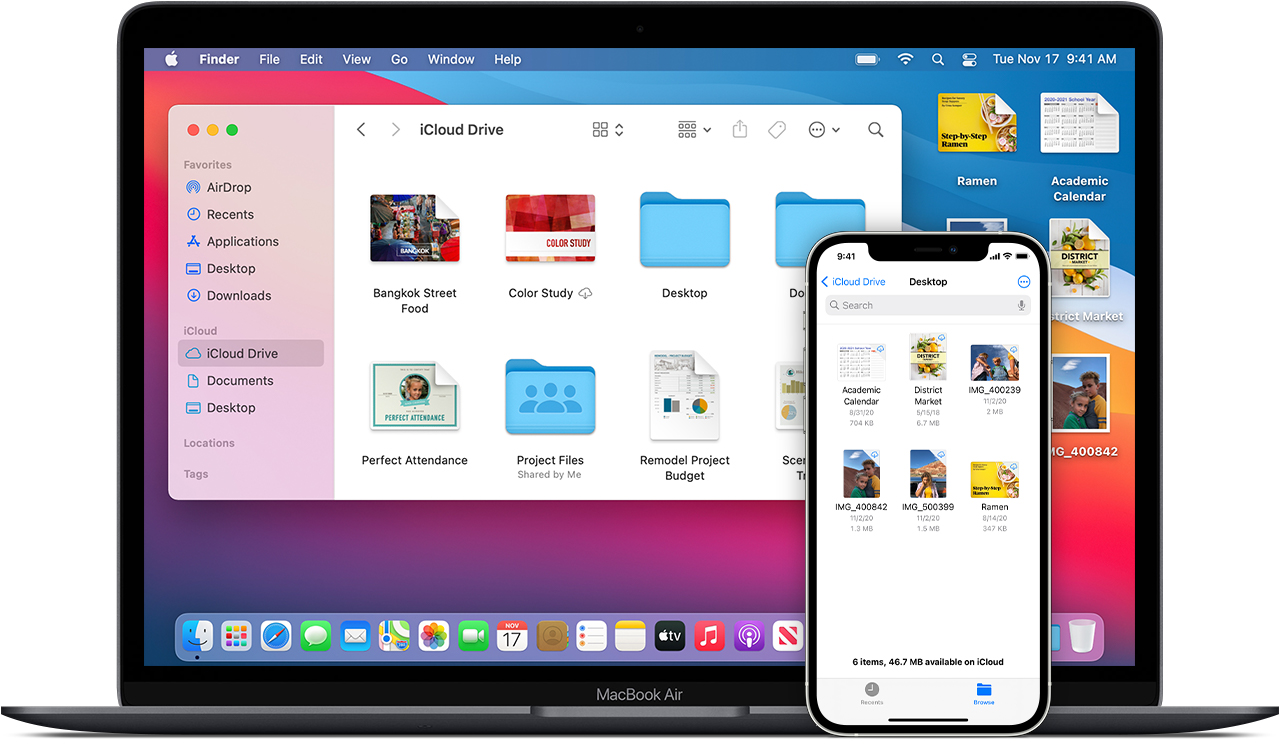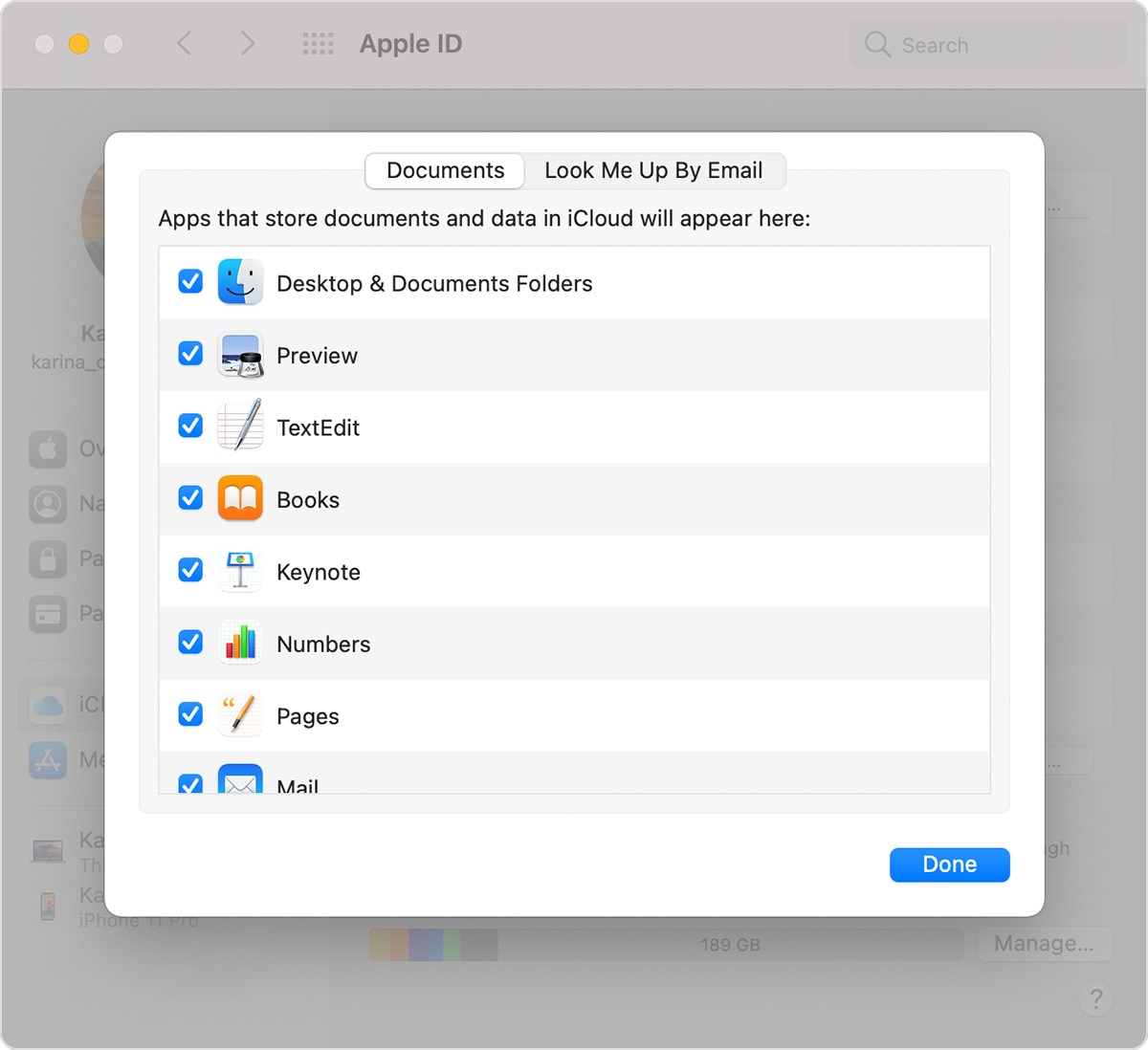How Can I Upload Folders From Computer to Icloud
Add your Desktop and Documents files to iCloud Drive
Learn how to share your files from your Mac Desktop and your Documents folder to all of your devices with iCloud Drive.

Turn on Desktop and Documents
Turn on Desktop and Documents on every Mac that you want to utilize with iCloud Drive.
- From your Mac, choose Apple bill of fare > System Preferences. Click Apple ID, then click iCloud. In macOS Mojave or earlier, choose Apple menu > Organisation Preferences, then click iCloud.
- Make certain that iCloud Drive is turned on.
- Next to iCloud Drive, click Options.
- Choose Desktop & Documents Folders.

- Click Done.
If you lot want to store your files in iCloud Bulldoze and another deject storage service, y'all can keep copies of your files in both, but you lot tin't continue folders from a third-political party cloud service in iCloud Drive. You can keep your other cloud service folders in a different identify on your Mac, like the home folder.
If you lot already use a feature from another cloud provider that syncs or manages your Desktop and Documents folders, yous need to plough information technology off to use Desktop and Documents.
Find your Desktop and Documents files on all of your devices
When you add together your Desktop and Documents to iCloud Drive, all of your files move to iCloud and any new files yous create are automatically stored in iCloud too. So you can find your files on all of your devices.
Your files upload to iCloud each time your device connects to the Internet. Depending on your Internet speed, the time it takes for you to see your files on your other devices might vary.
On your Mac
You can find your Desktop and Documents folders in the iCloud section of the Finder sidebar. If you add a second Mac Desktop, you can find those files in the Desktop folder in iCloud Bulldoze. Await for a binder with the aforementioned name as your second Mac. You tin can besides employ Spotlight to search for specific file names.
On your iPhone, iPad, and iPod touch
You can find the files in the Files app in iOS xi or later. You lot tin can utilize whatever uniform app to access and edit your files directly on your iPhone, iPad, or iPod touch.
If you're using iOS ix or iOS ten, you can access your files in the iCloud Bulldoze app.
On iCloud.com
- Sign in to iCloud.com with your Apple ID on your iPad, Mac, or PC.
- Get to iCloud Drive.
- Double-click the Desktop or Documents folder.
If y'all want to employ the file or brand edits, just click![]() and download information technology to your iPad or computer. When you're done making edits, upload the file to iCloud Drive to see the latest version everywhere.
and download information technology to your iPad or computer. When you're done making edits, upload the file to iCloud Drive to see the latest version everywhere.
Store your files in iCloud and save space on your device
The files that you keep in iCloud Drive use your iCloud storage. And as long as you lot accept enough space in iCloud, you can store as many files as you like.
If you need more space, yous tin can delete files to free up space in iCloud. When you apply iCloud Drive and delete a file on 1 device, it deletes on every device that you're signed in to with the same Apple ID. You can find deleted files in the Recently Deleted binder in the Files app or on iCloud.com for 30 days. After that, they're removed.
Acquire more than about how to manage your iCloud storage.
Plough off Desktop and Documents
- From your Mac, choose Apple tree menu > System Preferences. Click Apple tree ID, then click iCloud. On macOS Mojave or earlier, choose Apple tree carte du jour > Organisation Preferences, then click iCloud.
- Next to iCloud Drive, click Options.
- Deselect Desktop & Documents Folders.
- Click Done.
What happens when you turn off Desktop and Documents
When you turn off Desktop & Documents Folders, your files stay in iCloud Drive and a new Desktop and Documents binder is created on your Mac in the abode folder. You can motility files from iCloud Drive to your Mac every bit you demand them, or select all of your files and drag them to the identify you want to keep them.
What happens when yous plow off iCloud Drive or sign out of iCloud
If yous plough off iCloud Drive or sign out of iCloud, a new Desktop and Documents folder is created in your home folder. You also accept the option to proceed a local copy of your files that are in iCloud Drive. If you lot keep a local copy of your files in iCloud Drive, they're copied to a folder called iCloud Bulldoze (Archive) in your home folder. You can movement any files that were in your iCloud Desktop and Documents to your new local Desktop and Documents.
Published Date:
Source: https://support.apple.com/en-us/HT206985
0 Response to "How Can I Upload Folders From Computer to Icloud"
Post a Comment